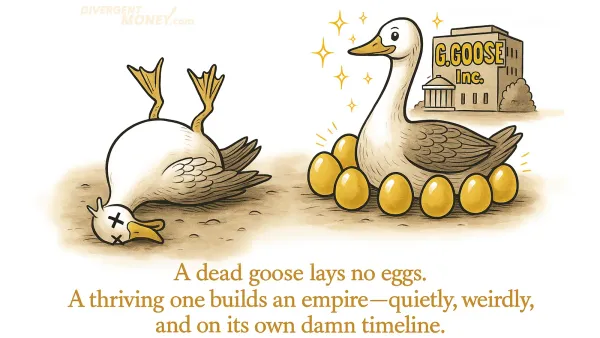“I Thought It Was Me”: What ND-Friendly Workplaces Actually Look Like

(And Why Most Offices Still Fail the Quiz)
I once got written up for not making eye contact during a meeting. I was fighting off a full-body shutdown because the fluorescent lights, rapid agenda shifts, and someone’s citrus hand lotion had completely fried my nervous system. So yeah, I wasn't exactly on my "making eye contact" game.
This happened before I was diagnosed autistic.
I was exhausted, overwhelmed, and failing to function in a workplace that was supposedly “inclusive.” But what exactly is inclusivity? Read on...
We Need to Talk About What “Inclusive” Really Means
You’ve probably seen the posters—We welcome diversity!
You may even have an HR training or two under your belt.
But here’s the reality: most workplaces that claim to support neurodivergence are unintentionally hostile.
Not out of malice.
Out of default settings built for neurotypical brains.
Things like:
- Surprise meetings that derail focus
- Rigid 9-to-5 hours that punish variable energy levels
- Open offices with no escape from sound, movement, or light
- Productivity metrics based on hours instead of output
- No real path for employees to ask for what they need without fear
And yet…
When ND people are actually supported—through real accommodations, flexible structures, and leadership that listens—they don’t just survive.
They thrive.
If you’re reading this at work right now—hiding in a bathroom stall, noise-canceling headphones on, wondering if it’s just you—you’re not alone.
The Quiz: Is Your Workplace Really ND-Friendly?
We made this quiz for two kinds of people:
- 🧠 ND folks trying to survive in a system that often doesn’t fit
- 🧑💼 Managers and HR leaders who think they’re doing okay—but maybe haven’t looked under the hood
This isn’t a gotcha.
It’s a gut-check.
Take 90 seconds.
Answer honestly.
And then see where your workplace actually lands.
Is Your Workplace ND-Friendly?
What Your Score Actually Means
🚨 0–10 Points: “I Thought It Was Me”
If you scored here, your workplace likely follows rigid norms that cause ND employees to mask constantly—or burn out trying.
“I cried in the bathroom three times a week before I realized the job wasn’t broken. The system was.”
Things that helped:
- ND-led workshops on communication, energy cycles, and masking
- A quiet room with dimmable lighting (not just a wellness poster)
- Letting people opt out of social events without social penalties
⚠️ 11–20 Points: You’re Trying, But...
You’ve started down the right path, but your workplace still leans neurotypical by default. Some things work, others don’t.
“We had flexible hours, but only if you explained why. I didn’t want to disclose my ADHD just to get a later start time.”
Things that helped:
- Switching from daily standups to asynchronous updates
- Visual project boards (like Trello or Tiimo) instead of verbal-only briefings
- Replacing “soft skills” hiring screens with work samples
✅ 21–30 Points: Solid Foundation
You’ve got ND-aware practices in place. Employees are probably breathing easier. But small friction points still add up.
“I felt safe asking for noise-canceling headphones. That’s never happened before.”
Things that helped:
- Anonymous suggestion boxes for accommodations
- Manager training from actual ND trainers, not just DEI consultants
- Explicit norms around communication (e.g., “It’s okay to Slack instead of talk”)
🏆 31–40 Points: ND-Inclusive, For Real
You’re setting the gold standard. Employees feel safe, supported, and heard. Retention is up. So is creativity.
“I stopped masking. For the first time, I don’t dread Mondays.”
What’s next?
- Share what’s working with your industry
- Offer peer mentorship and feedback loops
- Keep learning—neurodiversity is a spectrum, not a checklist
The Truth: ND-Friendly Helps Everyone
Flexible deadlines.
Clear communication.
Quiet spaces.
Options for how to meet, work, and deliver.
The funny thing? Once those ND-friendly changes were made—like cutting surprise meetings and offering quiet workspaces—the neurotypical folks loved it too.
One reader told us, “I didn’t realize how much masking I was doing until I changed jobs and stopped crying before work.” That hit us hard—and we’ve heard it more than once.
These aren’t fringe accommodations. They’re just good design.
In a world where burnout is rising, attention is scattered, and mental health is a top priority… maybe building ND-friendly workplaces isn’t a “nice to have.”
Maybe it’s the smartest, most human thing we can do.
Want to Build Something Better?
We work with organizations every day that want to move from aware to inclusive. If you’re an HR leader, manager, or ND employee ready to advocate for change, we’d love to hear from you.
📩 Reach out. Let’s build workplaces where everyone can thrive.
📚 Related Reads from Divergent Money
- Money Mindset for Autistic Adults
- Stack the Wins: Small Victories Improve Motivation (Especially for ADHD)
- Hyperverbalism: When Your Brain Doesn’t Know When to Stop Talking
🔍 FAQ: Neurodivergence at Work
Q: What does ‘masking’ mean in the workplace?
A: Masking refers to suppressing or hiding one’s natural behaviors (like stimming, avoiding eye contact, or needing breaks) to appear more “typical.” It’s exhausting and often unsustainable.
Q: What’s one easy thing any workplace can change right now?
A: Allow asynchronous updates instead of mandatory meetings. Many ND folks process and communicate better in writing.
Q: Should accommodations only be given if someone discloses a diagnosis?
A: No. Universal design benefits everyone. Create policies that don’t require personal disclosure just to be treated fairly.
Disclaimer: As ALWAYS, this article is for educational and motivational purposes and is not financial advice. Always consider consulting with a financial professional for guidance tailored to your unique situation.




